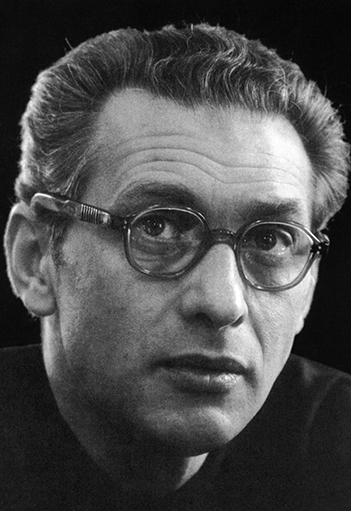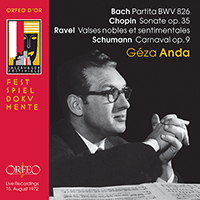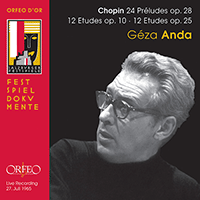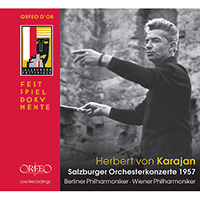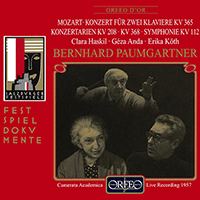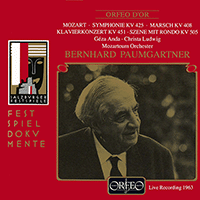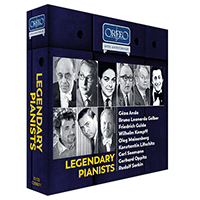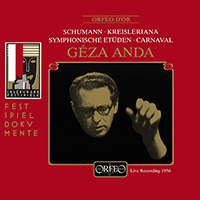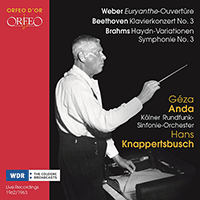Géza Anda
The son of amateur musicians, Anda entered the Franz Liszt Academy in Budapest at the age of thirteen. His most important teacher was Ernő Dohnányi, with whom he spent his last two years at the Academy. At the age of nineteen Anda won the Liszt Prize, which led to his debut with the Budapest Philharmonic Orchestra under Willem Mengelberg with Brahms’s Piano Concerto No. 2 Op. 83. After graduating from the Liszt Academy in 1941, at Wilhelm Furtwängler’s suggestion Anda went to Berlin for further study. He gave his Berlin debut with Furtwängler and the Berlin Philharmonic Orchestra playing the Variations Symphoniques by César Franck. Obviously in a dangerous location at this time, Anda was to be conscripted into the Hungarian army, but friends helped him to escape to Switzerland. He settled in Zürich and after the end of World War II spent a period of time in Paris, absorbing French music and culture under the guidance of Pierre Souvchinsky. He gave some concerts in Paris and gradually expanded his career, performing in Scandinavia, England and Israel. Anda first appeared at the Salzburg Festival in 1952, and over the next twenty-three years performed there nineteen times with orchestra and gave eight solo recitals. His reputation gradually grew, helped by his recordings for Columbia. In November 1955 he made his orchestral debut in New York with the Philadelphia Orchestra and Eugene Ormandy, again with Brahms’s Piano Concerto No. 2 Op. 83, and he gave his New York recital debut a few weeks later. He then made the first of his fifteen tours of the USA, playing with many of the great American orchestras.
From the early 1960s Anda worked with the Camerata Academica, a group of performing musicians comprising members of the Salzburg Mozarteum. Anda conducted them from the keyboard and they played all Mozart’s piano concertos (with Anda’s own cadenzas) as they toured parts of Europe in the 1960s. They recorded all the concertos for Deutsche Grammophon between 1967 and 1972. In 1970 Anda took part in the Mostly Mozart Festival in New York where he directed the New York Chamber Orchestra from the keyboard, and in 1971 he made major tours of America, Canada and South Africa. Six years later, at the age of fifty-four, Anda died, struck down by cancer, although he managed to give concerts up to a few months before his death.
Anda was also a highly respected teacher, taking over Edwin Fischer’s master-class in Lucerne from 1960 to 1969. He gave regular classes in Zürich, London, Paris, and at the Salzburg Mozarteum. Anda was first married in 1953; in 1964 he married for the second time, to Hortense Bührle, who came from a wealthy Swiss family. His life was one of refined style, elegance and sophistication, and these facets were reflected in his playing. Everything was approached with intelligent sensitivity, refinement and taste whether it be Bach or Bartók. There was never a sense that Anda would lose control, even in works such as Liszt’s Sonata in B minor, and this fastidious style has led him to be described as a poet rather than a virtuoso.
His first records were released as 78rpm discs. For Boîte à Musique he recorded some of Brahms’s late pieces, and in 1943 he recorded Schumann’s Études Symphoniques Op. 13 for Deutsche Grammophon. This early recording is very fine, showing Anda’s liking for inner melodies, his lightness of touch, and careful use of the pedal. Other titles he recorded in the 78rpm era were virtuoso works in the form of Liszt’s Mephisto-Waltz (edited by d’Albert) and La Campanella (arranged by Busoni), as well as an étude and two mazurkas of Chopin.
In the early days of the LP Anda made a series of recordings for Columbia in England, beginning in 1953. These have recently been reissued as eight compact discs on the Testament label with assistance from Anda’s widow. There is a fine disc of Schumann’s Carnaval Op. 9, Études Symphoniques Op. 13 and Kreisleriana Op. 16, although in this last work and many of Anda’s Liszt performances the dramatic elements of the music are played down, resulting in a low-voltage performance of Liszt’s Piano Concerto in E flat. Although the technique displayed in Liszt’s Mephisto-Waltz is impressive, a certain elegance masks the visceral excitement, both here and in some of Chopin’s Op. 25 Études. A live performance of these études from 1965 has more drama and interest. The recording of Liszt’s Piano Sonata in B minor is predominantly lyrical, tender and introspective. More successful is Bartók’s For Children, in which Anda’s purity and simplicity of tone are ideal.
Returning to Deutsche Grammophon at the beginning of the 1960s, Anda made many successful discs. He recorded the work with which he made his debut (Brahms’s Piano Concerto No. 2) with the Berlin Philharmonic Orchestra in 1961 under Ferenc Fricsay, and again in 1968 with Herbert von Karajan. He performed Bartók’s piano concertos during the 1950s when few pianists did, and when he recorded them in 1960–61 with the Berlin Radio Symphony Orchestra and Ferenc Fricsay the Concertos Nos 2 and 3 won a Grand Prix du Disque. These excellent recordings still stand as a benchmark by which all others are judged. The complete recording of Mozart’s piano concertos for Deutsche Grammophon was also one of the first of its kind, and Anda’s pure, classical delivery allows the recordings to stand alongside the best modern ones, by Mitsuko Uchida and Murray Perahia.
© Naxos Rights International Ltd. — Jonathan Summers (A–Z of Pianists, Naxos 8.558107–10).







